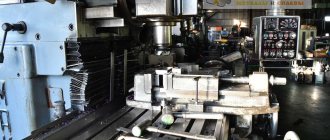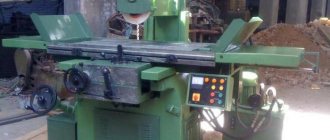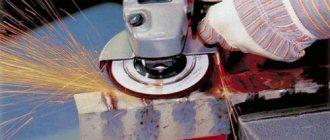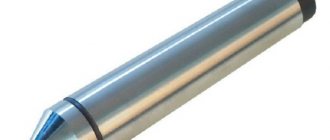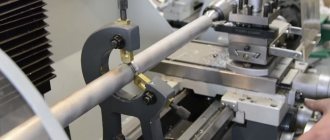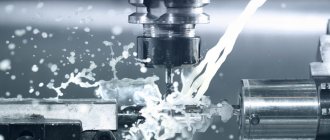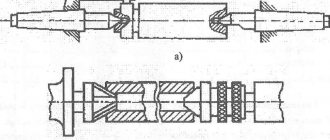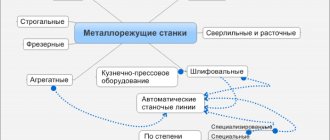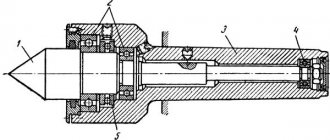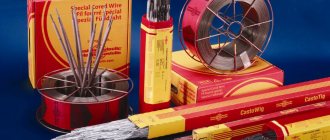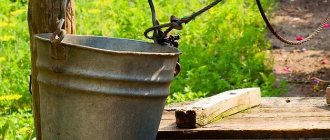Turning equipment is designed for processing workpieces from materials of various hardness - as a rule, they are used to produce parts that are bodies of revolution. Modern lathes are capable of processing external and internal surfaces that have a straight, conical or shaped shape.
The main cutting tools used to process parts are all kinds of cutters made of hard alloy metals, drills, lechers, taps, and countersinks. By and large, turning equipment is universal and can be used to perform various operations.
Types of processing performed on lathes
As mentioned above, almost all lathes can be classified as universal. By installing various cutting tools on them and using all kinds of technological equipment, you can perform the following operations:
- Grooving of internal and external rotation surfaces with different configurations.
- Drilling , reaming, reaming and countersinking holes along the axis of rotation of the workpiece.
- Cutting threads using a cutter, tool or die.
- Processing the ends of the workpiece.
- Parts alignment.
- When using additional equipment, it is possible to perform a grinding .
And this is not a complete list of operations that can be performed using turning equipment. Modern machines of this type, equipped with software, are capable of producing a completely finished product in one or two installations - which is why they are classified as universal equipment called machining centers.
Where are lathes used?
The importance of the lathe in metalworking is not exaggerated. Not a single serious production can operate without such equipment. With it you can perform the following operations:
- various types of drilling;
- carving creation;
- trimming and turning the ends of parts;
- creation of cylindrical and cone-shaped parts;
- countersinking;
- milling.
Lathes are used in metallurgy, automotive industry, shipbuilding, aircraft manufacturing, and the manufacture of parts for industrial equipment.
Operating principle of lathes
The operating principle of turning equipment is quite simple, despite the fact that the machines of this class themselves are quite complex units. Processing of the workpiece is carried out on them by combining two types of movement - rotation of the spindle, in the chuck of which the workpiece is installed, and longitudinal movement of the carriage with the cutter mounted on it. This tool moves along the axis of rotation of the workpiece, thereby cutting off a certain layer from it. Exactly the same principle is used to process the material using other tools.
Which metal lathe to buy: recommendations for choosing
To make the most of your investment, you need to know how to choose a lathe. Small-sized equipment with low power is suitable for a home workshop or garage. Recommendations for selection:
- Machine power supply. For home use, it is better to choose a model that can be connected to a 220 volt network.
- Spindle speed adjustment available. It is desirable that this function be present in the selected model.
- Weight up to 80 kg. This weight will be enough to keep the machine stationary while processing workpieces. Such machines can be moved around the workshop independently.
- Dimensions. The dimensions of the equipment should be less than the free space in the room. It is important to leave space for unobstructed access to any part of the machine.
- Availability of a guarantee and the ability to return the machine for service if it breaks down.
- Cast frame. It must be made of durable materials to withstand constant loads.
To find out the structure of the equipment, you can look at the diagram of the lathe. It will indicate key components, connecting elements and mechanisms for configuration.
Small dimensions of the machine
The most popular machine models
For their own use, home craftsmen choose metal lathes from the manufacturers JET and OPTIMUM. These companies are considered the most popular in terms of price and quality. They produce models both for their own workshops and for factories. The average price for JET equipment reaches 150,000 rubles. On average, you will have to pay about 250,000 rubles for a machine from OPTIMUM.
Important Features
Before purchasing turning equipment, you need to pay attention to its technical characteristics and compare them with the parameters of the parts that are supposed to be processed. Among these characteristics, special attention should be paid to the following:
- Maximum diameter of the workpiece being processed.
- Distance between centers - this characteristic determines the maximum length of the workpiece.
- Diameter of installation of the workpiece above the caliper.
In addition, important characteristics of turning equipment are the power of the main drive of the machine, working feed ranges, and maximum spindle rotation speed.
Basic parameters of a lathe
When choosing a metal lathe, you need to take into account its main characteristics. They are indicated in the technical data sheet of the equipment. You need to pay attention to the following parameters:
- Control Panel. Budget models may not have a spindle speed controller.
- Machine weight. When the electric motor operates and the cutter spins, powerful vibrations are created. The more powerful the engine, the heavier the machine should be. Industrial equipment is equipped with cast frames that dampen vibrations and prevent the machine from moving during operation.
- Dimensions. This option must be selected based on the available space in the room. Industrial equipment is more than garage or workshop models.
- Drive power. The harder the metal will be processed, the more powerful the equipment you need to buy.
- Nutrition. For low-power models - 220 volts, for industrial machines - 380 volts.
- Workpiece size. The more parts a lathe can machine, the more versatile it becomes.
Also, in different models, reverse may or may not be present. Its switching is carried out using levers or throwing the belt.
Lathe with control panel
Types of machines and their features
Today there are 7 main types of lathes
- Screw-cutting lathes , which are also called universal. This is the most common group of turning equipment, the main distinguishing feature of which is the ability to combine the rotation speed and longitudinal movement of the tool. The uniter of these movements is a special worm screw, which is how these machines got their name.
- Vertical lathes . Their distinctive feature is a large work table with a rotating faceplate.
- Lobe lathes . Their main purpose is to treat frontal surfaces. This type of turning equipment is highly specialized.
- Turret lathe . A distinctive feature of this equipment is the presence of a turret head, which allows for quick changes of cutting tools, which ultimately reduces the production process time.
- Automatic longitudinal turning machine . It is used in conditions of mass and batch production for the manufacture of small-sized parts.
- Multi-spindle automatic lathe . Its main feature is the processing of parts with complex surfaces.
- Turning and milling machining center . This is universal equipment capable of completely producing the required part in one or two installations. It is used for both serial and piece production.
In addition, one should not lose sight of the fact that almost all turning equipment can work under the watchful eye of modern software.
Code of turning machines
When designating the code for machines in a turning group, the first digit 1 indicates the group of machines. The second number indicates the type of lathe. The subsequent numbers, as a rule, show the technological parameter of the machine, namely: the maximum diameter of the workpiece, the height of the centers, etc. The letter after the first or second code can symbolize the generation of the machine, the manufacturer or modification. The letter placed at the end of the digital code may indicate an improvement in the base model or the accuracy class of the machine.
Here are some examples of the designation of lathe models.
1K62 - number 1 - group of lathes; 6 — turning and wine-cutting machine; 2 — height of centers, dm; letter K - generation.
1A616 - figure - group of lathes; 6 — screw-cutting lathe; 16 — height of centers, cm; A - generation.
1B811 - number 1 - group of lathes; 8 — turning and backing; 1 - technological parameter that determines the dimensions of the workpieces being processed; B - generation.
16K20P - number 1 - group of lathes; 6 — turning screw-cutting; 20 — height of centers, cm; K - generation; P - accuracy class - increased.
It should be noted that the sixth type of machines includes screw-cutting lathes, and the eighth type includes backing lathes. In the machine tool industry, the majority of manufactured metal-cutting machines, including lathes, are manufactured according to state standards; in which the main parameters correspond to normal or size ranges. By dimensional or normal series we mean a group of similar machines, consisting mainly of standardized units and parts, each of which is designed for processing parts of certain sizes,
The size ranges (standard sizes) of universal screw-cutting lathes and two-column rotary lathes are given in table. 1.
Table 1.
The table shows that the main parameter that determines the standard sizes of machines is the dimensions of the installed part. Moreover, each subsequent standard size of the machine makes it possible to process a part with a diameter 1.26 times larger than that of the previous part. Thus, for universal screw-cutting lathes and rotary machines, the denominator of the size range is set to 1.26. In other words, the series of numbers is 250; 320; 400; 500; 630; 800; 1000 (2300; 3200; 4000; 5000; 6300; 8000) form a geometric progression with a denominator of 1.26.
The maximum height of the installed part on rotary machines also changes according to the law of geometric progression with a denominator equal to 1.26: 2000, 2500, 3200. The presence of two naturally changing main parameters: the largest diameter of the installed part and its heights makes it possible to also regularly change other technical characteristics machine: power of the main drive, weight of the installed part, etc.
According to the degree of specialization, all machines are divided into universal, specialized and special.
Universal machines are machines that can perform various operations on a wide range of parts.
Specialized are machines that can perform a limited number of operations on parts of the same type.
Special machines are machines designed to perform a limited number of operations on parts of one standard size.
Features of working on a metal lathe
To create high-quality products on a lathe, you need to take into account some features and recommendations of experienced craftsmen. Tips for use and maintenance:
- Before starting work, you need to check the fastenings of the main parts, cutters and workpiece. They should not move when touched. It is also important to pay attention to the initial setup.
- It is not recommended to place foreign objects or tools on the bed.
- After turning off the machine, the working surface and cutters must be blown using a compressor.
- Moving elements must be lubricated to prevent jams.
- When working with workpieces, you must wear safety glasses to avoid getting chips in your eyes.
After completing the work, you need to clean the machine from accumulated dirt and production waste.
Do not work with damaged cutters, drills and cutters. CNC machines require constant diagnostics. People with programming experience can work behind them. The operator sets up a program according to the algorithm of which the moving elements will move and the engines will operate. Lathes are key equipment in various types of production. With their help, you can perform a number of operations that make human work easier.
